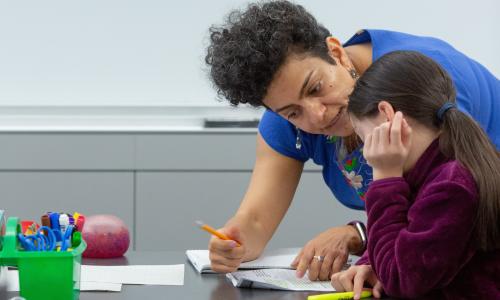When English language learners (ELLs) need additional support around reading, figuring out the appropriate kinds of support and instruction can take some time, but some basic information can also make a significant difference for students!
Keep in mind that ELLs can be both over-identified for special education, which means they are referred for services when they aren’t needed, as well as under-identified (not referred for services when they are needed). Dr. Debbie Zacarian explains that sometimes this results in a pendulum swing in which educators over-correct in one direction in order to avoid the other.
Before making any decisions:
- step back and look at the bigger picture
- take a look at what’s happening in the students' peer groups
- think carefully about what that different kinds of support might look like
- assemble a team of colleagues with different areas of expertise (if one does not yet exist in your setting) that includes ELL educators, bilingual educators, reading specialists, and special educators to help make informed and thoughtful decisions about next steps
- consider whether students have adequate medical care that has allowed them to have vision and hearing screenings or other services impacting their experience in the classroom
- avoid jumping to conclusions without sufficient information, such as assuming that special education services are the answer or assuming that a child's difficulties are due to their ELL status
Video: Challenges in Special Education Identification for ELLs
Dr. Alba Ortiz is one of the nation's leading experts on questions of special education for English language learners (ELLs). In this in-depth interview with Colorín Colorado, Dr. Ortiz discusses challenges related to special education identification, ideas for making ELL families an integral part of all decisions related to students, and best practices for instruction.
Video: Over- and under-identification of ELLs with disabilities
Dr. Debbie Zacarian describes why identification of ELLs with disabilities is so challenging to get right.
ELL Considerations
Looking at the big picture
Consider how your ELLs compare to their larger "true peer" group, including other ELLs with similar educational, language, and literacy backgrounds. Looking at this data with a team can be beneficial so that multiple perspectives are included. Are there any patterns among students who speak a specific language? Are there particular skills that a cohort of students need help with?
Here are two examples:
- After analyzing assessment data, a team of teachers and support specialists realized that third graders at Claremont Immersion School in Arlington, VA were struggling with drawing conclusions. You can learn more about the assessment-instruction loop they used to inform their teaching in our related video.
- Teachers at Wolfe Street Academy in Baltimore, MD noticed an increase in special education referrals among their Spanish-speaking students. After taking a closer look, they realized that they had a “hidden” population of Indigenous Mixtecan students who spoke Mixtec as a first language, Spanish as a second language, and English as a third language. Due to the stigma related to their Indigenous identity in Mexico, the families had not felt comfortable sharing the fact that their children spoke Mixtec at home with the school. This also explained why the students used unusual structures of speech such as saying “The car went fast fast.” (You can learn more about the unique considerations of partnering with Indigenous families in our related guide.)
Assessment for ELLs
Learn how third-grade teacher Samantha Kirch uses informal assessment in her classroom to better evaluate ELLs and their progress.
Support for families who speak Mixtec
Principal Mark Gaither talks about discovering the Mixtecan population at his school.
Henry Sales: Why Indigenous Families May Hide Their Identity
Henry Sales (Mam) explains why Indigenous families from Latin America may be reluctant to share their language or culture due to the discrimination they may have faced or continue to encounter.
Partnering with families
If you are looking at a particular student’s situation, it’s helpful to learn as much from the family about the student’s educational and literacy background as possible. (See step 2 in this document from Rhode Island, as well as this interview form.) This may provide valuable information that would otherwise be overlooked, such as whether the same challenges appear in both languages or only in English. In addition, it establishes an important partnership in the event that further evaluations and services are needed.
Considering special education services
If you are considering whether a student needs special education support, we encourage you to take a look at the following articles and resources, which lay out some of the nuances and challenges around special education identification for ELLs. Developing collaborative progress monitoring systems that examine each student’s particular situation, such as multi-tiered systems of support (MTSS), is critical.
Recommended Resources
Articles
- A Word Beginning with "T": "Maestra"
- 5 Myths About English Language Learners (ELLs) and Special Education
- Helping English Language Learners Succeed with a Multi-tiered System of Support (MTSS)
- English Language Learners in Special Education: How to Partner With Your Students' Families
- ESOL and Special Education Collaboration: A Teacher's Perspective
Guides and resources
- Practical Guidelines for the Education of English Language Learners: Research-Based Recommendations for Instruction and Academic Interventions
- Project Lee (Portland State University)
- Language and Reading Interventions for English Language Learners and English Language Learners with Disabilities (Center on Instruction)








Add new comment